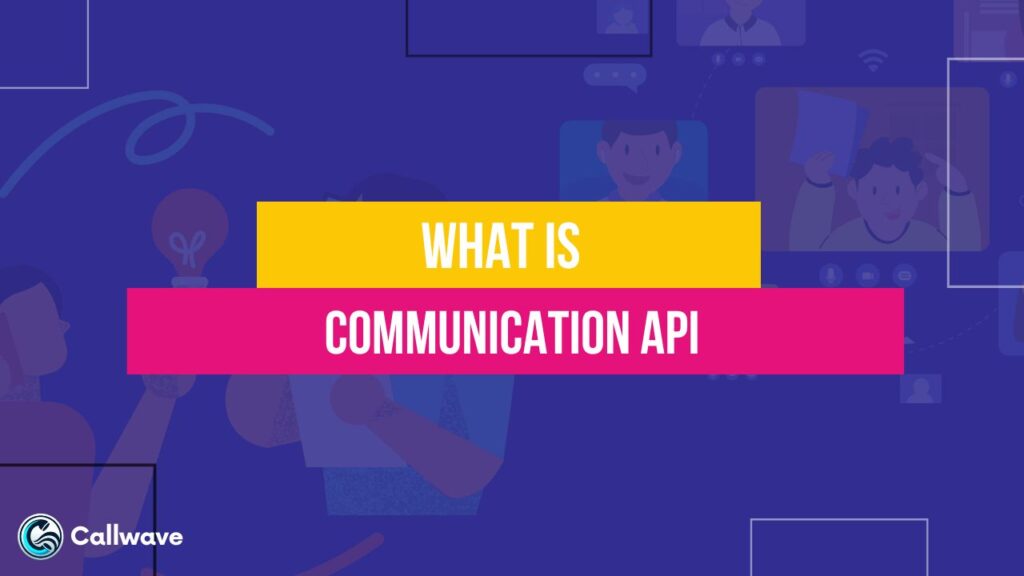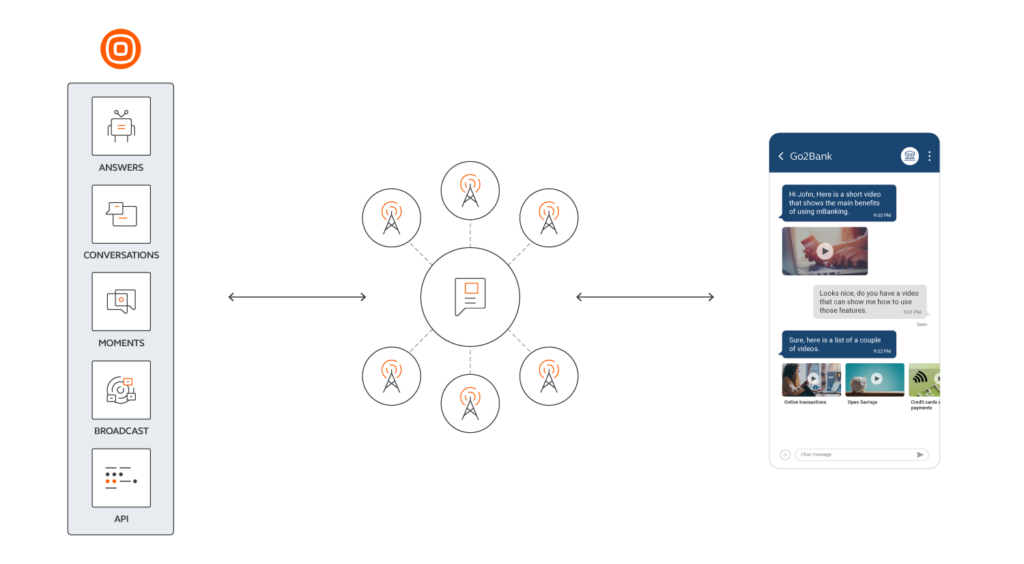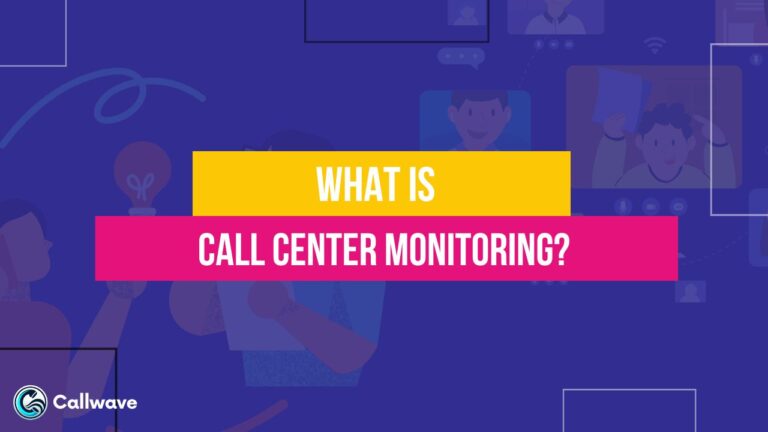A Communication API (Application Programming Interface) is like a special messenger that allows different software applications to talk to each other and exchange information seamlessly.
It essentially provides a way for different software programs to communicate and interact with each other by defining a set of rules and protocols.
Let’s understand it in a much simpler way.
Imagine you have two friends who speak different languages and want to communicate. The Communication API acts as an interpreter, translating their messages back and forth so they can understand each other perfectly.
It’s like having a real-time translator that enables smooth conversation between programs that would otherwise be unable to communicate directly.
These APIs provide a set of rules and protocols that define how different applications should interact and share data.

Different Types of Communication APIs
1. Voice APIs
Voice APIs allow developers to integrate voice communication capabilities into their applications. These APIs enable features like Voice over IP (VoIP) calling, conferencing, text-to-speech conversion, and speech recognition.
Popular examples include Twilio Voice API, Vonage Voice API, and Amazon Chime SDK. With Voice APIs, applications can initiate and manage voice calls, record audio, and integrate advanced voice functionalities like call queues and interactive voice response (IVR) systems.
2. SMS, MMS, and RCS APIs
These APIs enable applications to send and receive text messages (SMS), multimedia messages (MMS), and rich communication services (RCS) messages.
SMS APIs like Twilio Messaging, Vonage SMS API, and AWS SNS allow developers to programmatically send and receive SMS messages from their applications.
MMS APIs extend this functionality to include multimedia content like images, videos, and audio.
RCS APIs, such as the Google Jibe RCS API, offer an enhanced messaging experience with features like read receipts, typing indicators, and rich media sharing.

3. Chat APIs
Chat APIs provide developers with the ability to integrate real-time messaging and chat capabilities into their applications.
These APIs enable features like one-on-one and group chat, presence management, file sharing, and push notifications.
Popular examples include SendBird Chat API, and Stream Chat API.
Chat APIs are commonly used in applications like messaging apps, collaboration tools, and customer support platforms, allowing users to communicate in real-time through text, voice, and video.
4. Emergency Calling APIs
These APIs are specifically designed to enable emergency calling capabilities in applications.
They allow users to initiate emergency calls to local emergency services, such as 911 in the United States or 112 in Europe.
Examples include the Google Emergency Location Service API and the Bandwidth Emergency Calling API.
These APIs ensure that emergency calls are routed to the appropriate Public Safety Answering Point (PSAP) and provide critical location information to aid emergency response.
5. Notification APIs
Notification APIs allow developers to send notifications to various channels, such as push notifications, email, SMS, and in-app notifications.
These APIs enable applications to deliver timely and relevant updates to users, regardless of their location or device.
Examples include Firebase Cloud Messaging (FCM), Apple Push Notification Service (APNs), and Twilio Notify.
Notification APIs are widely used in mobile applications, web applications, and backend systems to keep users informed and engaged.

How Do Communications APIs Work?
At their core, Communications APIs act as intermediaries or bridges between different applications or systems that need to communicate with each other.
They provide a standardized way for these applications to exchange data and interact with each other, regardless of the underlying technologies or programming languages used.
Here’s a step-by-step explanation of how they typically work:
- Providing an Interface: Communications APIs expose a set of rules, protocols, and methods that define how different applications should interact with each other. This interface acts as a contract or agreement between the applications, specifying the types of data that can be exchanged, the format in which it should be sent and received, and the actions that can be performed.
- Making Requests: When an application needs to communicate with another application or service, it sends a request to the Communications API. This request typically includes the specific action or operation the application wants to perform, along with any necessary data or parameters.
- Processing the Request: The Communications API receives the request and processes it according to its defined rules and protocols. This may involve validating the request, authenticating the requesting application, translating the data into a format that the receiving application can understand, and performing any necessary transformations or calculations.
- Communicating with the Target Application: Once the request has been processed, the Communications API communicates with the target application or service on behalf of the requesting application. This may involve sending the processed data to the target application, retrieving data from the target application, or executing a specific operation or functionality provided by the target application.
- Returning the Response: After the target application has processed the request and performed the necessary actions, it sends a response back to the Communications API. This response may include data, status updates, or any other relevant information requested by the original application.
- Delivering the Response: The Communications API receives the response from the target application and processes it according to its defined rules and protocols. This may involve translating the data into a format that the original requesting application can understand, performing any necessary transformations or calculations, and ensuring that the response adheres to the agreed-upon interface.
- Returning the Result: Finally, the Communications API returns the processed response to the original requesting application, allowing it to receive the data or the result of the requested operation.
This process happens seamlessly and transparently, enabling different applications to communicate and exchange data without having to understand the internal workings or technologies of each other.
The Communications API abstracts away the complexities of communication and provides a consistent and standardized way for applications to interact.
It’s important to note that Communications APIs can be implemented in various ways, such as REST APIs, WebSocket APIs, or library integrations, depending on the specific communication requirements and the technologies involved.
However, the basic principles of providing an interface, processing requests and responses, and facilitating communication between applications remain the same.
Why These APIs are Needed?
Communication APIs are needed for several important reasons:
- Bridging Different Technologies: Modern applications and systems are often built using different programming languages, frameworks, and technologies. Communication APIs provide a standardised way for these disparate technologies to communicate and exchange data with each other, enabling seamless integration and interoperability.
- Enabling Third-Party Integrations: Many applications and services need to integrate with third-party services or platforms, such as payment gateways, social media platforms, or cloud storage providers. Communication APIs allow developers to easily integrate these external services into their applications, leveraging their functionalities and data without having to build everything from scratch.
- Simplifying Complex Communication Processes: Certain communication processes, such as voice and video calling, messaging, or push notifications, can be complex and involve many intricate steps. Communication APIs abstract away these complexities, providing developers with a simple and consistent interface to implement these functionalities without having to manage the underlying technical details.
- Scalability and Reliability: Communication APIs are typically provided by specialized companies or platforms that have invested heavily in building robust and scalable communication infrastructure. By using these APIs, applications can leverage this infrastructure and benefit from features like load balancing, failover mechanisms, and global reach, ensuring reliable and scalable communication capabilities.
- Rapid Development and Time-to-Market: Building communication features from scratch can be time-consuming and resource-intensive. Communication APIs offer pre-built solutions that developers can quickly integrate into their applications, significantly reducing development time and accelerating time-to-market for new products or features.

Are Webhooks Useful for Streamlining Business Processes?
Yes, webhooks can streamline business processes in several ways:
1. Real-Time Notifications and Updates
Webhooks enable applications to receive real-time notifications or updates from other systems or services.
This allows businesses to react quickly to events or changes, enabling faster decision-making and more efficient processes.
For example, an e-commerce application can receive a webhook notification from a payment gateway when a customer completes a purchase, triggering the order fulfillment process immediately.
2. Automated Workflows and Integrations:
Webhooks facilitate the integration and communication between different applications or services, allowing for the automation of workflows and processes.
When an event occurs in one system, it can trigger actions in other connected systems via webhooks, reducing manual intervention and increasing efficiency.
For instance, when a new lead is created in a CRM system, a webhook can automatically create a corresponding record in a marketing automation platform, streamlining the lead nurturing process.
3. Decoupled Architecture
Webhooks promote a decoupled architecture, where different components of a system can operate independently and communicate asynchronously.
This separation of concerns improves scalability, maintainability, and flexibility, as changes or updates in one system do not necessarily affect the others.
This architectural approach streamlines development and deployment processes, enabling businesses to adapt and evolve their systems more efficiently.
4. Event-Driven Architecture
Webhooks enable an event-driven architecture, where applications respond to specific events or conditions rather than constantly polling for changes.
This approach reduces unnecessary network traffic, improves responsiveness, and ensures that resources are only consumed when needed, leading to more efficient utilization of computing resources and cost savings.

5. Third-Party Integration
Webhooks simplify the integration of third-party services or APIs into business processes.
Instead of building custom integrations or continuously polling for updates, webhooks allow external services to push data and events directly to an application, streamlining the integration process and reducing development efforts.
6. Serverless and Microservices Architecture
Webhooks are well-suited for serverless and microservices architectures, where functions or small services are triggered by events.
This architectural approach promotes modularity, scalability, and cost-efficiency, allowing businesses to build and deploy applications more efficiently and respond to changing demands more quickly.
While webhooks are powerful tools for streamlining business processes, it’s important to consider factors such as security, reliability, and scalability when implementing webhook-based architectures.
Proper authentication, validation, and error handling mechanisms should be in place to ensure the integrity and reliability of the webhook-driven processes.
How to choose a good Communication API?
When choosing a communication API, there are several important factors to consider. Here are five key factors explained in an easy language:
Features: Different communication APIs offer different features and capabilities. Consider what features you need for your application, such as voice calling, SMS messaging, video conferencing, or real-time chat. Make sure the API you choose supports the features you require, so you don’t have to cobble together multiple APIs or build custom functionality.
Scalability: As your application grows, the communication API should be able to handle increasing traffic and usage without hiccups. Look for APIs that offer scalability, high availability, and reliable performance. This ensures that your users can communicate seamlessly, even during peak usage times or sudden spikes in demand.
Developer Support: Good documentation and developer support can make or break your experience with an API. Evaluate the quality of the documentation, the availability of sample code and tutorials, and the responsiveness of the API provider’s support team. Clear documentation and helpful support can save you a lot of time and frustration during development and troubleshooting.
Pricing: Communication APIs often charge based on usage, so it’s important to understand the pricing model and estimate your potential costs. Look for APIs that offer transparent and competitive pricing, as well as cost-effective plans that align with your project’s budget and anticipated usage levels.
Integration and Compatibility: Consider how the communication API will integrate with your existing systems, programming languages, and development frameworks. An API that seamlessly integrates with your tech stack can save you a lot of time and effort. Additionally, check if the API supports popular platforms and devices to ensure compatibility with your target audience.
While these are five key factors to consider, there may be additional factors specific to your project or industry.
It’s always a good idea to thoroughly evaluate your options, read reviews, and potentially test out different APIs before making a final decision.

The Bottom Line
From facilitating real-time messaging and voice calls to streamlining business workflows through event-driven architectures, these APIs bridge technological gaps and empower businesses to deliver exceptional user experiences.
As you explore suitable options, carefully evaluate features, scalability, developer support, pricing, and integration capabilities to ensure a perfect fit for your unique requirements.
With the right Communication API, you can unlock new levels of efficiency, responsiveness, and innovation, propelling your business towards sustained growth and success.
FAQs
Ques 1. What is an example of a communication API?
Ans: Twilio APIs allow developers to integrate voice, video, and messaging capabilities into their applications.
Ques 2. Why are APIs used in communication?
Ans: APIs enable different software systems to communicate and share data, facilitating seamless integration and functionality.
Ques 3. What is API in IoT?
Ans: In IoT, APIs act as interfaces that allow different devices and systems to connect, exchange data, and control each other.
Ques 4. How do you communicate with API?
Ans: APIs are communicated with through requests (e.g., HTTP requests) that follow a defined structure and protocol.
Ques 5. What is API testing in simple words?
Ans: API testing is the process of validating the functionality, reliability, and performance of an API by sending requests and verifying responses.
Ques 6. What is a free API?
Ans: A free API is a publicly available interface that allows developers to access and integrate data or services without any cost.






